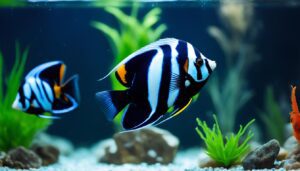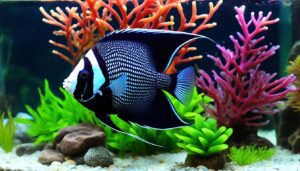Welcome to the exciting world of Zebra Angelfish care. Their beautiful stripes bring a piece of South American river beauty into your home. These fish are easy to breed and full of personality. Let’s dive into what it takes to keep your Zebra Angelfish healthy and happy, including their size and the best companions for them.
Imagine a Zebra Angelfish that grows up to 6 inches long. With their fins, they can reach about 8 inches tall. They look like a dinner saucer swimming around! These fish can live with you for 8 to 12 years, becoming part of your family.
Putting these peaceful but sometimes pushy fish into your tank adds excitement. But they can be a bit bossy when it’s time to mate. I’ll show you how to mix their need for space with the calm of community living. This way, everyone in your aquarium can get along peacefully.
Understanding the Majestic Zebra Angelfish
The Zebra Angelfish stands out in the Pterophyllum genus. It’s famous for its bold, zebra-like stripes. This fish isn’t just pretty. It also has freshwater angelfish characteristics that many people love. It comes from calm freshwater areas and does well in well-kept tanks that feel like home.
Zebra Angelfish are part of the Pterophyllum family. They have long fins and a sleek shape. This makes them swim gracefully. But, their vibrant stripes and calm yet lively nature set them apart. This is especially true in tanks with other fish.
Knowing how Zebra Angelfish behave is key if you’re thinking about getting them. They can be territorial when it’s time to mate. But they are usually peaceful with other fish. This makes them interesting to both new and experienced fish keepers.
These angelfish are impressive parents during breeding. They carefully pick partners and actively look after their young. They’re less likely to eat their eggs or babies if there’s enough room. This shows their complex social lives and the care they need to do well in a tank.
Future owners should make a stable and rich home for them. Try to match the warm currents of their natural habitat. Doing this helps keep Zebra Angelfish healthy. It also makes your tank look lively and beautiful.
To sum up, Zebra Angelfish are more than just their looks. They have fascinating habits and need specific care. This makes them a rewarding challenge for aquarium enthusiasts. They offer a chance to add beauty and interest to your tank.
Creating the Ideal Habitat for Zebra Angelfish
Making the perfect angelfish aquarium setup is a mix of art and science. It’s more than just filling a tank. You need to create a sustainable ecosystem. Here’s what you need for Zebra Angelfish.
Choosing the Right Aquarium Size
Choosing the right optimal tank size is key for Zebra Angelfish. Start with at least a 55-gallon tank for young fish or a small group. This gives them space to grow. If you have many fish types, consider 100 gallons or more. More space means less stress and happier fish.
Optimal Water Conditions for Health
It’s important to mimic the natural conditions for Zebra Angelfish. Aim for a water temperature of 76-86°F and a pH of 6.0-7.5. Also, keep the water’s hardness between 5-12 dGH. Regular checks will keep your fish healthy.
Decorating with Plants and Hiding Spots
Using aquatic plant decoration makes your tank look good and helps your fish. Plants like Java Fern and Amazon Sword offer hiding spots. They reduce stress and improve water quality by taking in nitrates and adding oxygen.
Setting up your angelfish tank is about more than looks. It’s about recreating the natural world of the Zebra Angelfish. With the right tank size, water conditions, and decor, you can make a great home for your fish.
Zebra Angelfish Diet: What to Feed Your Aquatic Pet
Feeding your Zebra Angelfish the right food is crucial for their health. Angelfish dietary needs must be met to keep their diet balanced. This supports their omnivorous lifestyle.
Zebra Angelfish eat both meat and plants. High-quality flake foods and a mix of live and frozen feeds are good. Adding angelfish live feed like baby brine shrimp helps their colors and breeding.
- Variety is Key: It’s important to change up their food. This meets their nutritional needs and makes feeding fun.
- Live Feeds: Foods like brine shrimp and bloodworms provide protein. They also help with health and aggression management.
- Vegetation: Plant matter in their diet is important too. Spirulina and spinach can be added for balance.
Here’s a quick nutritional breakdown and feeding tips for your Zebra Angelfish:
Food Type |
Benefits |
Frequency |
|---|---|---|
High-Quality Flakes |
Rich in essential nutrients; easy daily feed |
Daily |
Brine Shrimp |
Promotes growth and vibrant coloration |
2-3 times a week |
Bloodworms |
High protein source, good for conditioning |
2 times a week |
Plant Matter |
Balances diet, provides necessary fiber |
Once a week |
For detailed guidelines on freshwater angelfish care, check this care guide. It covers everything from diet to tank conditions. This guide makes caring for Zebra Angelfish simpler and helps them thrive.
Remember, feeding them right is key. Overfeeding leads to health issues. It’s better to feed them a little less than too much. Watching how they eat can also show if they’re healthy.
Navigating Angelfish Social Behavior in Your Tank
Getting to know the angelfish social dynamics is key for a happy tank. Angelfish are pretty but can be tricky to keep peaceful with others. It’s important to think about the tank setup and how the fish will get along.
Angelfish breeding behavior affects tank life a lot. When they breed, even calm angelfish may become aggressive. Giving them enough space and hiding spots can lower fighting.
Interacting with Other Angelfish
Angelfish like being with others and show it in different ways. They might gently peck or lock lips, showing friendship or fighting. Having at least four angelfish helps spread out aggression. It stops one fish from being picked on.
Handling Aggression and Territorial Issues
Aggression can be a problem, especially when angelfish want to spawn. Changing the tank’s scenery can help break up territories and lessen fights. If needed, dividers or special breeding tanks can keep aggressive fish from bothering others. Choosing peaceful tank mates like black skirt tetras and cory catfish helps too. These fish usually don’t upset angelfish.
Keeping angelfish with others is not just about their physical care. It also means looking after their social needs for a peaceful tank life.
Identifying and Selecting Healthy Zebra Angelfish
When adding Zebra Angelfish to my aquarium, I focus on their health first. It’s vital to inspect each fish closely before purchasing angelfish. The best choices are those that eat well, swim actively, and have no physical flaws. Their eyes should be clear, and their bodies should look well-fed, showing they’re healthy.
Also, I talk to the store staff and watch the angelfish eat. This helps me find the most lively ones. Angelfish health indicator is crucial. I look for fish up to 6 inches long with bright bands. These fish adjust well to new places and make my tank look great. I avoid sickly fish to keep my aquarium healthy.
I always aim to get the healthiest Zebra Angelfish for my tank’s well-being. Whether it’s a beautiful Naja gold with a yellow crown or a Marble angelfish, choosing strong fish is key. Knowing about their needs, like the semi-aggressive tank mate for Platinum angelfish, helps me care for them properly.

